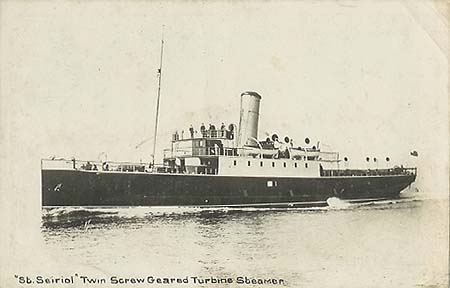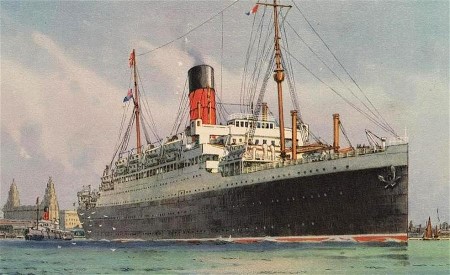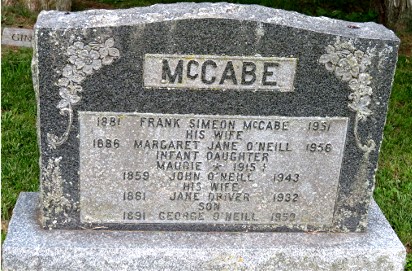|
Sep 1, 1891
|
Born in Peterborough, Ontario to John and Jane
(nee Driver) O’Neill
|
|
Nov 5, 1914
|
Attested into the 21st Battalion in Kingston, Ontario
Ø Number 59764 (temporary number 678)
Ø Next of kin given as John O’Neill, father, Napanee, Ontario
Ø Previous occupation given as Farmer
Ø No previous military experience given
Ø Religion given as Church of England
Ø Posted to “E” Company
o This was later reorganized into “C” Company
The 21st Battalion trained in the Kingston, Ontario
area through the winter of 1914-15.
|
|
Feb 10, 1915
|
Forfeited 1 day’s pay for an unrecorded offence
|
|
Apr 3, 1915
|
Sentenced to 5 days detention for an unrecorded offence
|
|
May 6, 1915
|
Embarked the RMS Metagama in Montreal, Quebec

|
|
May 15, 1915
|
Disembarked in Devonport, England and the
battalion proceeded to the West Sandling Camp, near Hythe, Kent to continue
training
|
|
Jun 3, 1915
|
Forfeited 1 day’s pay for being absent
|
|
Aug 11, 1915
|
Forfeited 1 day’s pay for being absent
|
|
Aug 31, 1915
|
Forfeited 2 day’s pay and restricted to half pay
for 1 month for being absent
|
|
Sep 14, 1915
|
Embarked the St. Seiriol in Folkestone

|
|
Sep 15, 1915
|
Disembarked in Boulogne, France and the battalion
proceeded to St. Omer
|
|
Nov 8, 1915
|
Proceeded on Bombing Course
|
|
Nov 14, 1915
|
Rejoined the battalion resting in Ridgewood,
Belgium from the Bombing Course
|
|
Dec 7, 1915
|
While in the front line near Voormezeele,
Belgium, Private O’Neill sprained his right ankle and was evacuated to the
No. 5 CFA (Canadian Field Ambulance) for first aid before being transported
to the Division’s Rest Station at the No. 6 Canadian Field Ambulance
|
|
Dec 11, 1915
|
Discharged to duty and rejoined the battalion
resting in La Clytte, Belgium
|
|
Dec 17, 1915
|
Not fully recovered from his ankle sprain,
Private O’Neill was re-admitted to the No. 5 Canadian Field Ambulance with
strained calf muscles in his right leg.
He was transported the same day to the 2nd Division Rest
Station at the No. 6 Canadian Field Ambulance
|
|
Dec 21, 1915
|
Transferred to the No. 8 CCS (Casualty Clearing
Station)
|
|
Dec 26, 1915
|
Discharged to duty from hospital care
|
|
Jan 3, 1916
|
Private O’Neill re-injured his right leg and was
admitted to the No. 5 Canadian Field Ambulance
|
|
Jan 6, 1916
|
Discharged to duty from the field ambulance
|
|
Feb 14, 1916
|
Attached to the Canadian Overseas Railway
Construction Corps for duty
|
|
Mar 5, 1916
|
Admitted to the No. 5 Canadian Field Ambulance
with a diagnosis that reads Bronchitis
|
|
Mar 7, 1916
|
Transferred to the Division Rest Station at the
No. 6 Canadian Field Ambulance
|
|
Mar 10, 1916
|
Discharged to duty
|
|
Apr 20, 1916
|
Ceased to be attached to the Railway Construction
Corps and rejoined the 21st Battalion
|
|
Sep 15, 1916
|
During the fighting on the Somme at the sugar
factory, Private O’Neill received shrapnel wounds to his right hand and
arm. He was evacuated to the nearby
field ambulance for first aid before being transported to the casualty
clearing station
|
|
Sep 17, 1916
|
Transferred to the No. 1 Convalescent Depot in
Boulogne, France
|
|
Oct 2, 1916
|
Discharged from the convalescent depot on being
classified TB (Temporary Base) and reported to the CBD (Canadian Base Depot)
in the Rouelles Camp, Havre, France
|
|
Oct 13, 1916
|
Classified “C”, meaning he was unfit for combat
duty and invalided to England
Transferred to the CCAC (Canadian Casualty
Assembly Centre) in Folkestone
|
|
Oct 16, 1916
|
Admitted to the Granville Special Canadian
Hospital in Ramsgate
Notes on admission
Ø Patient is very nervous and
stammers
Ø Heart rate is rapid and
unregulated
Ø Has headaches and is very weak
|
|
Dec 17, 1916
|
Discharged from hospital
|
|
Dec 18, 1916
|
Embarked the SS Andania in London

|
|
Jan 2, 1917
|
Disembarked in Halifax, Nova Scotia and proceeded
to Quebec City, Quebec
|
|
Jan 5, 1917
|
Medical Board in Quebec City notes
Ø Patient suffers from traumatic
Neurasthenia due to Shell Shock
Ø He is very nervous and tires
easily
Ø Stammers very badly
Ø He is easily excited and upset
by noise
Ø Patient requires at least 6
months rest in a convalescent home
|
|
Jan 9, 1917
|
Proceeded to Kingston, Ontario and admitted to
the Elmhurst Convalescent Home to be treated as an out-patient
|
|
Jan 25, 1917
|
Discharged from care of the convalescent home
|
|
Mar 5, 1917
|
Re-admitted to the Elmhurst Convalescent Home to
be treated as an out-patient
|
|
Mar 19, 1917
|
Medical exam in Kingston notes
Ø Man suffers from Traumatic Neurasthenia,
Shrapnel wound to right arm and a Goitre
Ø He stammers when slightly
excited and has an exaggerated knee jerk
Ø Thyroid gland is enlarged
Ø Recommended for discharge from
service with a 20% disability for 1 year
|
|
Apr 19, 1917
|
Discharged from the CEF in Kingston, Ontario
Ø Rank on discharge Private
Ø Entitled to War Service Badge
Class “A”
Ø Proposed residence on
discharge Napanee, Ontario
Following the end of the war, the 1914-15 Star,
British War Medal and Victory Medals were sent to him at Napanee, Ontario
|
|
Oct 1, 1918
|
Admitted to the Queen’s Military Hospital in
Kingston, Ontario with complications from his shrapnel wounds
|
|
Oct 2, 1918
|
Surgery performed under a local anaesthetic to
remove 2 pieces of shrapnel from his right forearm
|
|
Oct 6, 1918
|
Discharged from hospital
|
|
Jan 12, 1938
|
Married to Arlie Evelyn Spencer in Napanee,
Ontario
|
|
Jun 20, 1950
|
George Henry O’Neill died at home in Napanee,
Ontario and was buried in the Riverview Cemetery in Napanee

|
|